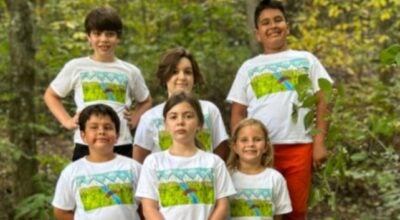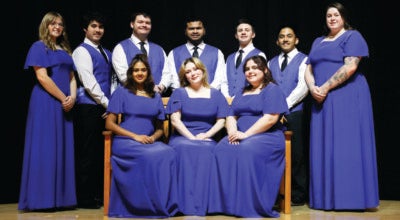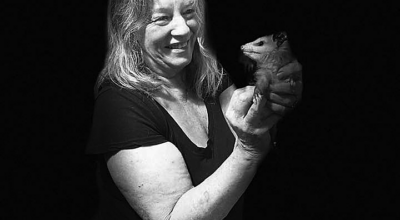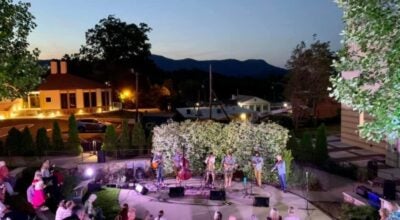Amy Brucksch &Keowee bringing classics to kids
Published 7:00 pm Friday, February 6, 2009
I ran into Amy Brucksch over the holidays playing with the Community Chorus and again at Tryon Federal Bank with a string quartet for their Christmas party. It took a few weeks, but we finally sat down for lunch at Simple Simon&squo;s to visit about her newest project that&squo;s keeping her on the go. Keowee Chamber Ensemble is one of the nine groups selected by the North Carolina Arts Council to be part of the 2009 cARTwheels Program. How long have you been involved with Keowee? This is my third or fourth year. This is starting their ninth season. I was brought in to the group. Kate Steinbeck, flutist and Elizabeth Austin a cellist started it. Originally it just was concerts and it evolved into a summer festival. Now it&squo;s a two week summer festival series. I first played four years ago on the festival. Since then it has expanded beyond the festival to where we&squo;re now doing outreach. We&squo;re doing residencies and workshops, getting grant funding from different sources to go out into the communities. The cARTwheels Program is the latest and actually by far the biggest of our series. How did that come about? The North Carolina Arts Council got in touch with us in August and said, &dquo;We have this cARTwheels program, and we&squo;d like you to apply for it.&dquo; I looked at it and said, &dquo;It seems like this is way too big for us.&dquo; I was thinking it would be large groups. This is the third year for the program. The first year, I believe, was dance. The second year they added theatre. This is the first year for them to add music groups to it. They said, &dquo;No, just make it into a big project.&dquo; That&squo;s where we got the idea of collaborating with Quarteto La Catrina which is a Latino string quartet. Right now they&squo;re based in Hickory. They&squo;re the artists in residence with the Western Piedmont Symphony which gets funding to have a string quartet in residence. This is the tenth year for that program. Quarteto La Catrina is their quartet in residence. Three of the members are Mexican, and one member is American from Savannah, Georgia. We approached them about collaborating with this cARTwheels proposal to present Latin American and Spanish chamber music. We were accepted as one of nine out of twenty-nine, which we thought was really incredible. As part of the grant funding do you have to hit certain subject areas? We needed to tie it to North Carolina teaching standards and programs of study. Education is a big component and it&squo;s funded by the state legislature specifically this program. It&squo;s definitely an education component. They wanted us to be able to tie it in to history, social studies, and language. Yesterday we did our first programs. How did that go? It was incredible. We played for about 1,500 children, two performances at the Civic Center in Vance County. It was just incredible. The energy and the quartet, they are phenomenal players. The percussionist that we have is wonderful and then we have two dancers from Charlotte who are involved in the project. They did flamenco dance and traditional tango with us and then the very end piece is a huapango which is a Mexican dance. Of course they had different costumes for each and the kids were just mesmerized. What grade level was this for? Third and fifth graders. That&squo;s what the state is targeting, those groups. We played basically for every third and fifth grader in Vance County. We got really great feedback and should be getting photos and a video back. Next we go to Transylvania County to Brevard and we&squo;ll be in the Porter Center there. It&squo;s really wonderful. We go to these wonderful venues and they bring the children to us. The kids get to experience what it&squo;s like to go to a big concert and see the staging. We also have art that&squo;s projected behind us or to the side of us on a big screen of Mexican and Latin American art. Hopefully it&squo;s sort of a synthesis for them to see the culture and the different aspects of it. Is it set up like a concert, or are you teaching at the same time? We speak a little bit. That was really kind of the purpose of the study guide which goes out to them. That keeps you from having to talk too much? It&squo;s a fifty minute performance. That&squo;s it. There are all sorts of scheduling issues with busing the kids into the venue. I was amazed yesterday with how smoothly it went getting the children in and out. That many kids, and they were great. I hadn&squo;t really expected 75o children to be able to sit through, but they did. They just seemed entranced by it, especially when the dancers came on. We do talk a little bit. We had Jorge who is the violist in the quartet speak. He speaks very good English and he can also speak in Spanish. That&squo;s part of the appeal of this program is that North Carolina has a growing number of Latino children. It&squo;s also for them to be able to experience their heritage. Will the cARTwheel program be in Polk County? I don&squo;t believe this year. My understanding is that half of the North Carolina counties receive one of the nine groups one year, and then the next year there is the opportunity for the rest of the counties. There are nine currently on the cARTwheels roster and I&squo;m not sure how the selection process goes. Keowee is a North Carolina non-profit? We&squo;re also a non-profit in South Carolina. Part of the festival is in Greenville. Also, we&squo;ve gotten grants from the South Carolina Arts Council. One that we received we did at a program in a pretty place at the YMCA camp up there for Down&squo;s syndrome children for a camp they have during the summer there. How was that? Wonderful, it was more of an interactive one where the children participate with us. We have rhythm instruments that we pass around to the kids. We now have a total of twelve little guitars that I take out. I usually will either teach the kids a couple of chords so they can do rhythms with us or even if that&squo;s a little bit too much I&squo;ll tune the guitar strings to an open chord so they can just strum along a rhythm with us. We try to teach them different kinds of rhythms so they can play with and perform with us often times. As a matter of fact, locally we got funding from a private donor and I did music for the FENCE summer camps this past summer and worked with the kids. We did guitar and a little performance at the end of the week. Have you done work with the schools before? We have done quite a few projects in Asheville. We did a residency at Evergreen Charter School that was funded by the Asheville Chamber Music Society. We did that for two years. One year was just a three day, and then we extended that the next year to where we came to the school and did percussion and guitar workshops for a period of six weeks. This then culminated in three intensive days with fifth graders who then performed with us for the rest of the school. What we try to do is really interact with the kids so it&squo;s not just a quick, &dquo;Here it is,&dquo; and we&squo;re gone. We also did one really exciting project that was funded by the Grassroots program in Asheville. I think it was a grant from the Asheville City itself. We went and did a series of workshops for seniors at their senior center there in Battery Park. We then went to the YWCA afterschool program and did a series of workshops with the kids. Then we also went to a homeless shelter in Asheville. That all culminated in a performance at the library in Asheville. We took the kids who played with us. It was open to the public. We do still have our two week summer festival which is the more traditional chamber music program. A really important part of our mission is outreach. Especially, developing new audiences and really targeting underserved populations or people who would not normally walk into a concert hall to hear chamber music. If my mom hadn&squo;t taken us into Seattle
to see the Symphony on discount tickets that came from her work, we never would have had that experience. I think that&squo;s what North Carolina is doing, especially with the cARTwheels program. They&squo;re really emphasizing how important it is for children to go ahead and hear music and see the performing arts in a way they might not. It&squo;s different than sitting and listening to a CD or watching a DVD to be at a live performance. Right, and of course we&squo;re big chamber music fans of the smaller more intimate groups as opposed to the orchestra. Not that there is anything wrong with that, but it&squo;s just a different kind of music. We often say that we do chamber music &dquo;out of the box.&dquo; We try to expand beyond the traditional string quartet or classical kinds of chamber music. With a smaller group is there more inter play between the musicians? Actually in our ensembles we do a little bit of improvisation which for classical musicians is surprising because we&squo;re so &dquo;paper trained.&dquo; It&squo;s been wonderful working with the quartet and also River Guerguerian who&squo;s a percussionist. He&squo;s played all over the world. We do a little bit of improvisation on the huapango and the tango. It is great in that kind of small ensemble there&squo;s a lot of eye contact. The things that happen in performance don&squo;t happen in the rehearsal. Sometimes it happens in a way that you didn&squo;t plan and it&squo;s even better than in a rehearsal that spontaneity. How did you get started with classical music? I started playing guitar around when I was second grade. I had bugged my parents for a guitar. I think there was a youth minister at the church we belonged to at the time who sang and played guitar. He did Peter, Paul, and Mary and I wanted to learn how to do Puff the Magic Dragon. The guitar that they bought me cost $15, a little three quarter size, which I still have. The sixth string rattled, and still rattles. They thought it was a phase and I wouldn&squo;t stick with it. I stuck with it. They got me lessons at a music store. I learned how to read music right away and of course I learned chords. After a couple of years, the instructor said, &dquo;Well, this is pretty much everything I know. You can kind of keep going like this or you could try classical guitar.&dquo; I said, &dquo;What&squo;s classical guitar.&dquo; He said, &dquo;Well it&squo;s hard and not very many people do it.&dquo; I said, &dquo;Oh, that&squo;s what I want to do.&dquo; My parents got an Andr´s Segovia recording and played it for me and I just loved that. It&squo;s the sound of the instrument, the classical guitar that enthralled me. You had to learn how to do it. Yeah, I stuck with it. I played throughout junior high. They got me lessons, an hour and a half one way from where we lived to study classical guitar with a woman in Toledo. She died when I was in about the eighth grade, so I was kind of on my own. My junior high choral instructor encouraged me to consider music as a college course of study. She recommended the University of Cincinnati and the conservatory there. We went down and met the woman Clare Callahan who is still teaching there. She encouraged me to start to get some lessons again through their prep department, which I did. I auditioned and was accepted. I got a Bachelor of Music degree in performance there with her. As I said she&squo;s still teaching there. She&squo;s a wonderful mentor. I go back now in the summer and am one of the teachers at the summer guitar institute that they have. It&squo;s really great to be back with her in that kind of environment again. It&squo;s always been a love for many years. It seems that often people who succeed with music start young and have their own drive to learn, not just a parent that&squo;s making them do it. My parents must have hit the right balance. They encouraged me. They got me lessons. I was never forced to practice. My first classical guitar teacher was this really wonderful woman named Irene Lawrence. She played music in a lot of different places across the 30&squo;s, 40&squo;s, and 50&squo;s. Not just classical music, a lot of the pop styles of guitar. She was a wonderful person for me to have because if I didn&squo;t like a piece her response was, &dquo;Well, there&squo;s lots of music we&squo;ll just play something else.&dquo; I was never forced to play music I didn&squo;t like. I guess the down side was that I had some technical holes that needed to be addressed when I went to college. Conservatory took care of that pretty quickly. Is this your full time job? Yes. Nice! It really is. I have to say that my husband is an occupation therapist. We do have a secure stable job as a back up. I taught at the University of Toledo for eighteen years as a classical guitar professor there. When we moved down here, I needed to take a break and step back and say, &dquo;Okay, what is it that I want to do.&dquo; Kate came into my life in terms of chamber music and I&squo;ve grown from there. Would you go back to the University? Probably not full time, but I miss the collaboration with other faculty members. Keowee has filled that void. I do private teaching. I personally have a real problem with trying to recruit music majors, especially in classical guitar when there are no jobs really other than what you create yourself. There are wonderful classical guitar programs around the country now. So many more than when I was college age. I didn&squo;t feel like it was very ethical to encourage students to major in classical guitar. Even though you did so yourself? Exactly, I had some really wonderfully talented students, but you know what it&squo;s like as an artist. You have to really want it, and I just felt like if someone really wanted it there were lots of good schools to go to. If someone came to me with that kind of talent I would encourage them to go to one of those places rather than study at a mid-level institution. At a mid-level institution they may have some connections, but not everything you&squo;ll need for a job. Right, at the conservatories, the big music schools, they&squo;re turning out lots of music majors and what do they do? It&squo;s incredibly competitive. The violinist with La Catrina Quartet takes about one orchestral audition per year. For a major orchestra, if a position opens up there are 150 applicants, and that&squo;s after you&squo;ve sent a resume. You can&squo;t just show up to audition, you have to send a resume and they decide whether you&squo;re worth their time to come in and listen to for an audition. That&squo;s just on paper without ever hearing you? Right, then you can send a CD of yourself playing. Then after they listen to 150 people, they might not take any of them. If they do accept someone, it may be for a one year temporary appointment to try you out. It can be pretty discouraging. Not that we want to discourage anyone from being in the arts. You have to understand how much work you&squo;re going to have to do to make a living. I was lucky, my teacher in college early on said, &dquo;Here are the odds. If you really want it, here&squo;s what you&squo;re going to have to do.&dquo; I don&squo;t know that a lot of students realize that when they come out with that four year degree, &dquo;Okay, world here I am.&dquo; Keowee Chamber Music: Kate Steinbeck, flute; Amy Brucksch, guitar; River Guerguerian, percussion La Catrina Quartet: Daniel Vega-Albela and Blake Espy, violins; Jorge Martnez, viola; Alan Daowz, cello Charlotte Salsa Dance: Wendy and Rodrigo Jimenez (photo submitted)How long did it take to put the cARTwheels program together? The repertoire that we chose, some of it Keowee had already been doing. Some of it the Quartet had already been doing. You sort of split the difference? For example, the Quartet had already perfor
med the huapango. It&squo;s actually an orchestral piece they had arranged for string quartet. So we added percussion, guitar, and flute to it and then we have the dancers. We changed it around a little bit. We&squo;re doing a Boccherini guitar quintet that has the fandango in it which is a Spanish dance. Boccherini is an Italian composer from the eighteenth century, but he wrote this incredible movement that has the fandango in it, so the dancers are doing flamenco dance. That&squo;s a guitar and string quartet that both the Quartet and I were familiar with. We basically had three rehearsals with all the musicians and then we added the dancers. Not too bad, it came together quickly. What&squo;s your personal practice schedule like? I have to have my hands on the instrument one to two hours a day just for physical maintaining technique, flexibility, concentration, brain stuff. Ideally, if I get in two to four hours a day I feel great. Now obviously a lot of things interfere with that. I&squo;ve also expanding to doing improvisation, not necessarily jazz improvisation or flamenco, but just exploratory. Going out there and seeing how I can open up creative outlets in my brain. Have you written music? Not specifically. I guess that may be where the improvisation may head to, especially with Kate and River. River&squo;s very comfortable with rhythm improvisation. It&squo;s something perhaps to look forward to? It&squo;s a whole new outlet for me. I can pretty much play whatever is put in front of me, but I&squo;m working on getting away from the printed page and exploring what kinds of sounds I make when I just go to that other part of the brain. I try to spend some time doing that every day. For more information about Keowee Chamber Music and the cARTwheels program visit www.keoweechambermusic.org or the North Carolina Arts Council page at www.ncarts.org.





